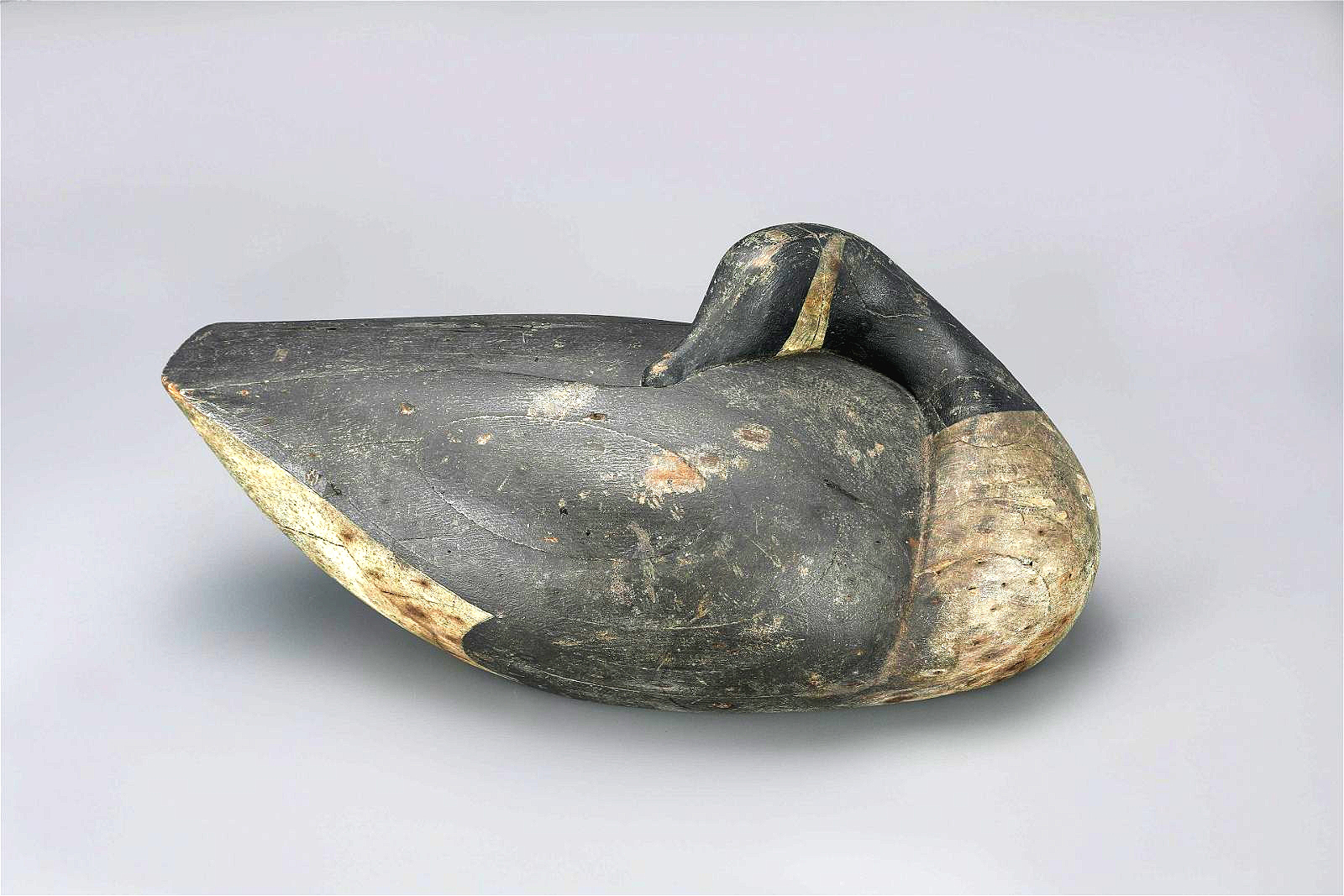
Deservedly the highest price decoy in the sale, this sleeping goose from the Evans collection was made about 1920 by Charles Safford of Newburyport, Mass. It attained $594,000.
Review By Rick Russack; Catalog Photos Courtesy Copley Fine Art Auction
HINGHAM, MASS. — When Antiques And The Arts Weekly visited Copley Fine Art Auctions’ gallery the week before the two-day July 13-14 Sporting Art Sale, Colin McNair, Copley’s decoy specialist, took a few minutes to discuss the collection of Thomas Evans Jr, which was to be sold on the first day of the sale. He also discussed the early evolution of reference material on the subject of decoys.
The decoys from the Evans collection included seven which sold for more than $100,000 each.
Evans, a successful businessman, holds numerous records as a world-class tarpon and marlin fly fisherman, having caught several world record fish. He became interested in collecting decoys in 1972, when he attended the first of Richard Bourne’s landmark sales of the Mackey Collection. Evans is quoted in Copley’s catalog, “The best carvings were going for five to ten thousand dollars apiece, way too pricey, so I left empty handed.” That changed in 1996, when he bought an Elmer Crowell raised wing curlew at auction, and the rest is history. The decoys in this sale represented only a portion of the collection and included several birds that had been in the Mackey collection, as well as one (which did not sell) that included folk art legends Adele Earnest and Stewart Gregory in its provenance.
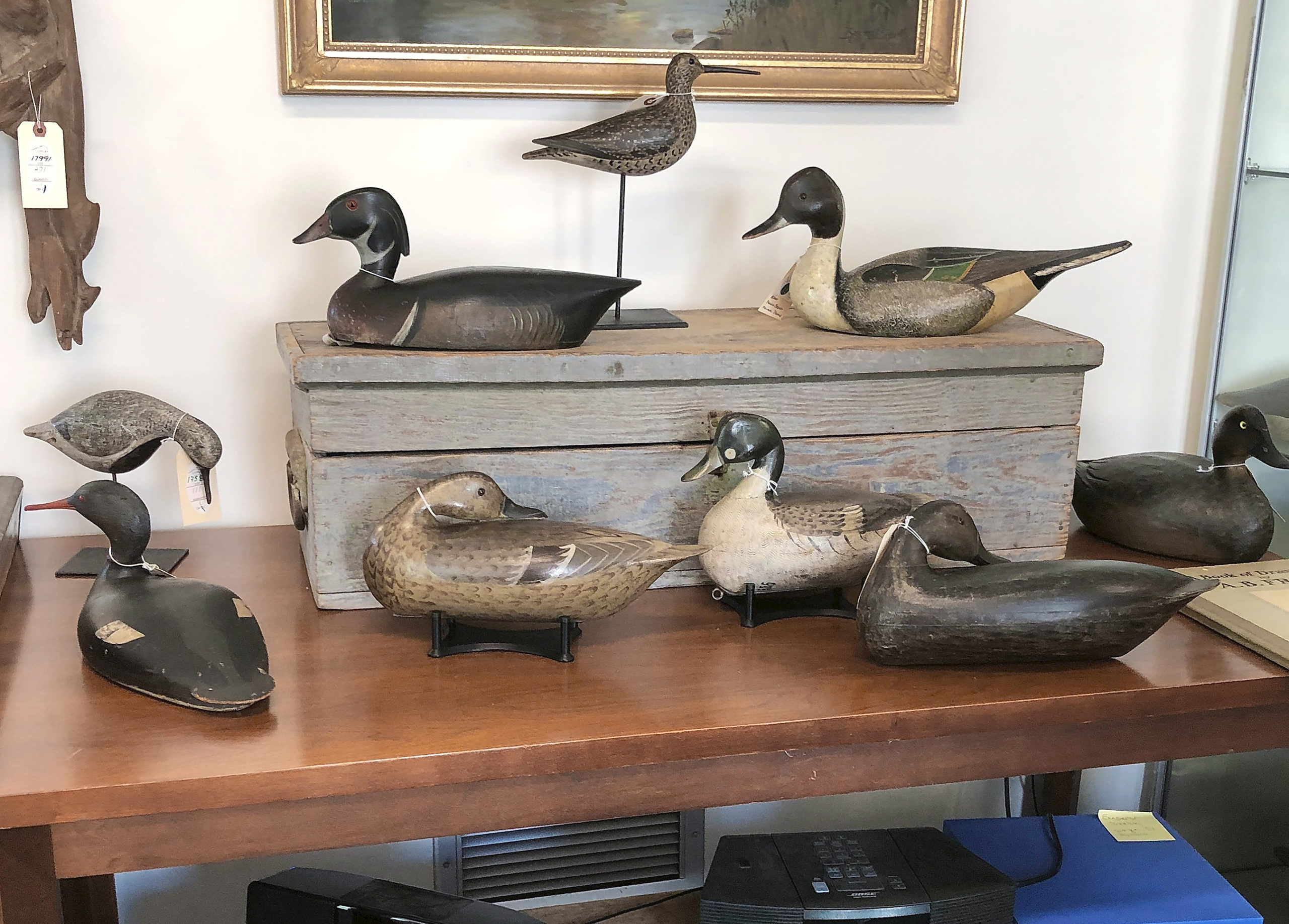
Decoys on parade! A very small portion of Copley’s preview.
McNair pointed out that both Earnest and Mackey published books in 1965; at the time they were just the second and third books on the subject of decoys, the first being Joel Barber’s Wildfowl Decoys, which had been published in 1934. McNair said that both recognized exceptional decoys, but they approached the subject from totally different perspectives. In The Art of The Decoy: American Bird Carvings, Earnest, a pioneer in the folk art world who owned a gallery, approached decoys as works of art, and she had a strong appreciation for decoys as folk art. Mackey was a hunter and sportsman and considered decoys as artifacts of the sportsman’s world. His well-researched book, American Bird Decoys: The Authoritative Story of Our Classic Bird Decoys and Their Makers, approached the subject from that point of view. Many decoys from Mackey’s collection are considered the best of the best today and decoys that passed through Earnest’s hands have strong cross-over appeal to folk art collectors as well as decoy collectors.
The Mackey collection was sold in a series of landmark auctions held by Richard Bourne in the early 1970s. Catalogs of those auctions are in most decoy collectors’ libraries. Other decoys in the Evans’ collection had been part of the respected McCleery collection, which was sold by Sotheby’s in 2000; others had been in the Linda Johnson collection. It’s safe to say that decoys in the Evans collection had blue-ribbon provenance.
The 16 Evans decoys, seven of which sold for a combined total of $1,512,000, kicked off the sale and provided the star of the sale. A sleeping goose made by Charles Safford of Newburyport, Mass., circa 1920, was the highlight of the collection and the sale; it realized $594,000. In her 2013 catalog for the 2013 “Massachusetts Masterpieces” exhibition at the Museum of American Bird Art, decoy scholar Gigi Hopkins said this carving “leaps into the pantheon of the greatest American goose decoys ever made, sculpture and function in perfect marriage.” The decoy was constructed of more than 20 pieces of cross-laminated wood and retained its original paint, showing only slight gunning wear. The first two lots of the Evans collection were a pair of mergansers by New Hampshire’s George Boyd. Both had been in the McCleery collection, and the decision was made to sell them separately. The drake earned $150,000; the hen earned $120,000. The pair will remain together as they were bought by the same phone bidder.
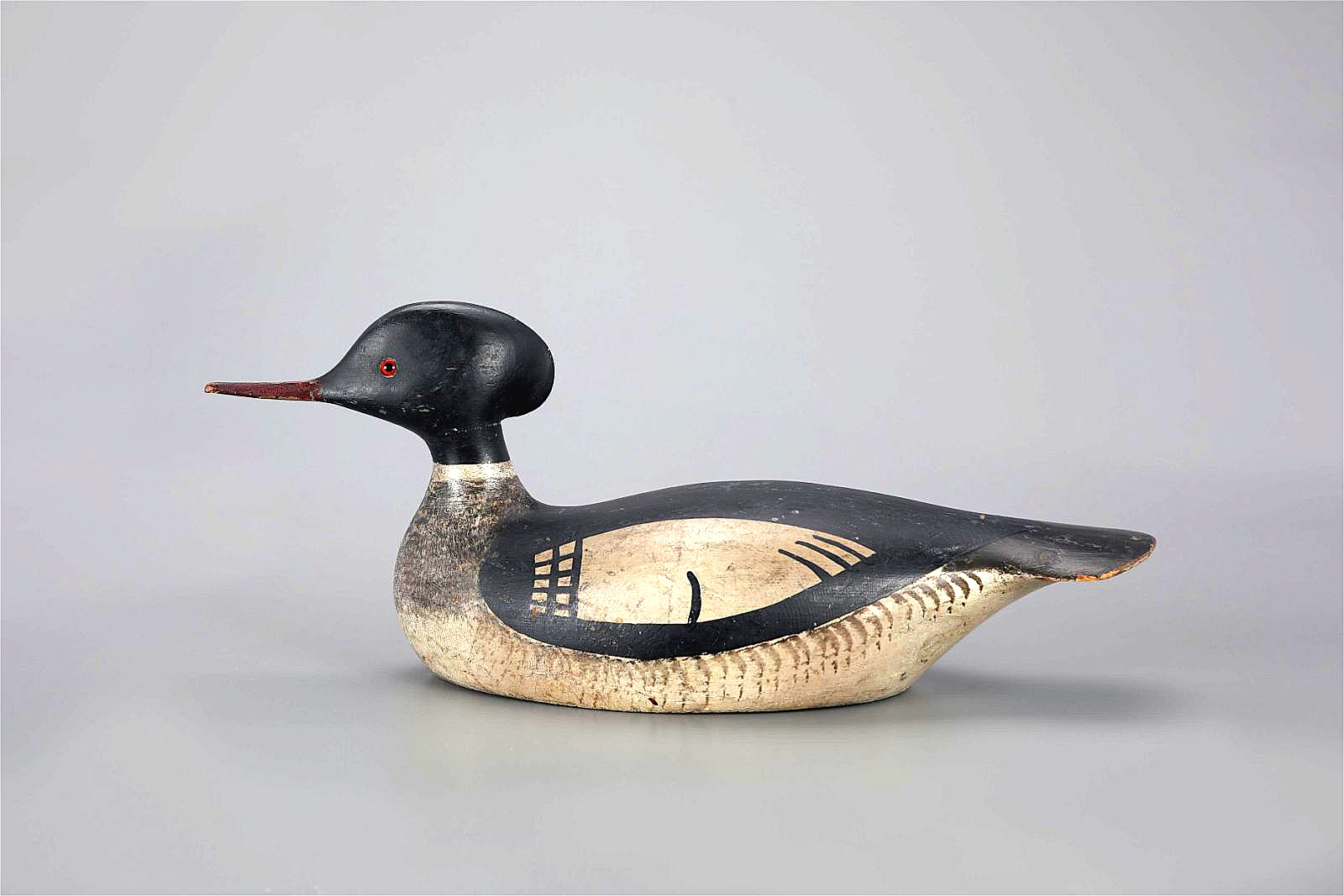
Getting the sale started with the first lot, this merganser drake made by Seabrook, N.H., carver George Boyd realized $150,000. The hen, its mate, realized $120,000. The pair was from the Evans collection and both sold to same phone bidder.
The Evans collection provided some of the other highlights of the sale. A brightly painted wood duck made by Canadian carver Thomas Chambers, about 1900, realized $264,000. It is believed to be one of only two wood duck by Chambers and had appeared on the dust jacket of The Bird Decoy: An American Art Form and was included in other books as well. Two decoys by New Jersey master Harry Shourds that had both been in the Mackey Collection were sold to the same buyer for $120,000 each. One was a merganser in original condition; the other was a long-tail dating to about 1890 that has been extensively documented, both in exhibitions and in print. This species was once known as an “oldsquaw” and now gets its name from the two long feathers protruding from the drake’s tail.
In addition to the six figure prices in the Evans collection, about two dozen other decoys, sold in the rest of the sale and representing the work of master carvers from various parts of the country, each brought more than $10,000; several pieces of sporting art also resulted in five- and six-figure results.
Realizing $40,800 was a black duck in a preening position by the husband-and-wife team of Charles and Edna Perdew. He did the carving and she did the painting, resulting in decoys many consider among the premier examples of the art. This circa 1910 black duck had been exhibited several times and appeared in many publications. A frequently published and exhibited Illinois river goldeneye drake by Verne Cheeseman reached $49,200. Cheeseman was a friend of the Perdews and the catalog states “he employed the services of Edna Perdew to paint many of his decoys, and, at times, it can be challenging to distinguish between a Cheeseman and a Perdew.” The catalog goes on to say “this is not only the finest Cheeseman decoy, but one of the finest goldeneye decoys from the Midwest.”
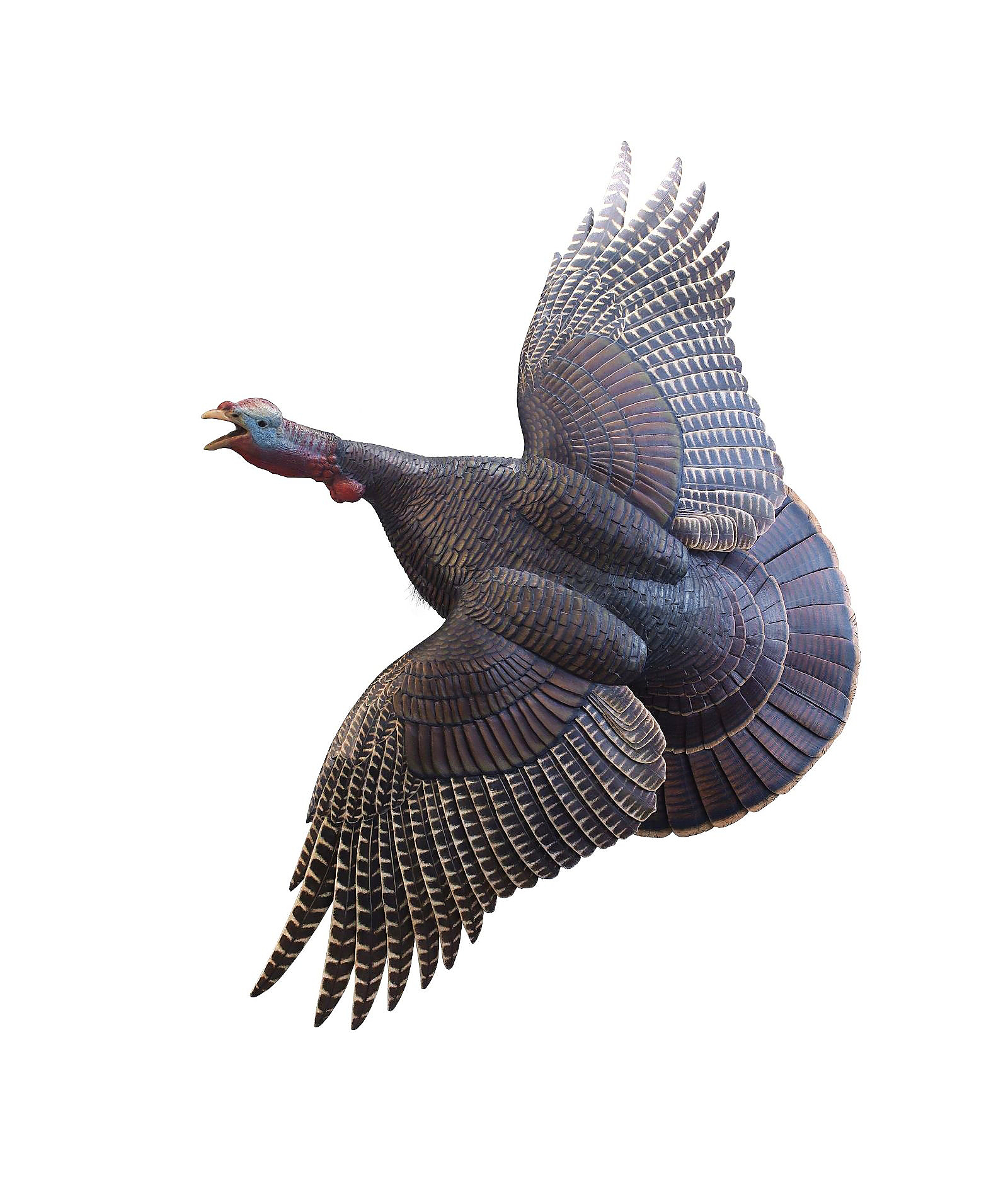
‘Extraordinary’ is the only word to describe this life-size carving of a wild turkey in flight, by Frank Finney. Only one other example was made about a decade ago. Its wingspan is 58 inches, and it was bagged for $48,000.
Decorative carvings included two that really had to been seen to be appreciated. Although the catalog gives its size, 48 inches long with a wingspan of 58 inches, Frank Finney’s life size carving of a wild turkey in flight was truly impressive. Finney is one of today’s most respected carvers, with examples often bringing five figure prices, and this finely detailed one may have been his largest. It sold for $48,000. The other carving that had to be seen to be appreciated was Stephen Smith’s life-sized tarpon. The catalog said it was 88 inches long and 38 inches wide. The head is detailed, and the scales are individually carved and lifelike, with the scales painted in a meticulous and accurate way. The overall effect is overwhelming, and it made $18,000. Smith said it was unlikely that he would ever carve another.
More decorative carvings included at least 20 produced by Mark McNair, who, along with carvings by his sons, have a strong following. Bringing $8,400 was an early long-tail drake, circa 1980, which had remained in McNair’s family, with a “not for sale” tag, for years. It was his first long-tail and the number “1” is inscribed on the base.
McNair is believed to have made only about six Harlequin ducks; the one in the sale brought $5,700.
Copley’s sales always include a good selection of sporting art by a variety of artists, and prices were strong and included a new world record. It was a watercolor by Aiden Lassell Ripley (1896-1969), “Dove Shooting” painted in 1947 and was signed and dated. It more than doubled its estimate, finishing at $114,000. There were three other works by Ripley in the sale, including a circa 1950 watercolor, “Gobbler and Hen Turkey” which realized $16,800.
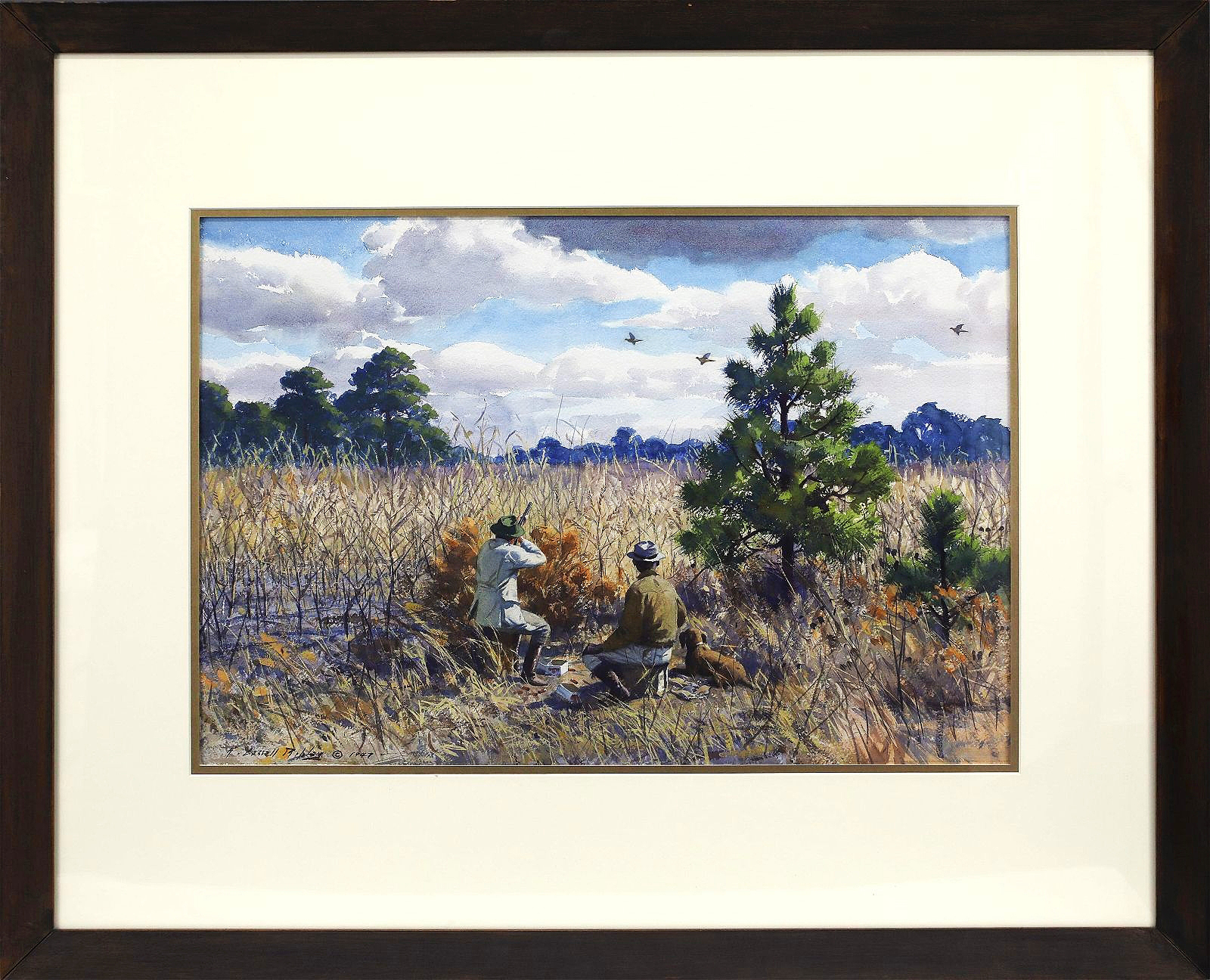
Setting a new world record for a watercolor by Aiden Lassell Ripley was this depiction of doves in flight brought $114,000, more than doubling its estimate.
The subject matter of sporting paintings often includes wonderful paintings of dogs and anglers. A watercolor by Samuel A. Kilbourne (1836-1881) depicted a large Atlantic salmon breaking the surface of a stream; it swam to $13,200. Thomas Blinks (1860-1912) was a well-respected self-taught English artist who produced detailed paintings of dogs and horses. His works are in numerous museums and his painting of two English setters sold for $45,000. Arthur Fitzwilliam Tait (1819-1905) grew up in England but came to the United States in 1850 and became well known for his detailed sporting subjects. He frequently painted quail families; one of those paintings, “Quail and Chicks,” signed and dated 1867, brought $36,000. Copley’s catalog has a lengthy synopsis of Tait’s career.
Cougars were a frequent subject of works by wildlife artist Bob Kuhn (1920-2007). A 1977 acrylic depicting a cougar on a log sold for $49,200. Kuhn grew up in Buffalo, N.Y., and spent time as a child sketching the inhabitants of the Buffalo Zoo. He made his living as an illustrator and his works today are in numerous museum collections. An unusual gouache by perennial favorite Arthur Burdett Frost (1851-1928) earned $46,800. “Winter Golf – Play the Like in Four!” was a self-portrait of the artist and showed him golfing on a frozen pond with his two sons as caddies. It was used as a full-page illustration in an 1899 issue of Harper’s Weekly. There were numerous limited-edition sporting drypoint prints and etchings by Frank Benson, which sold between $840 and $6,600 depending on subject matter, technique and edition size.
Stephen O’Brien said, “We can never be disappointed with a sale that brought in more than $3.5 million. That said, it would have been nice to have sold a few more of the Evans decoys; I think collectors will look back at this as a missed opportunity.”
Prices quoted include the buyers’ premium as reported by the auction house.
For additional information, www.copleyart.com or 617-536-0030.




























